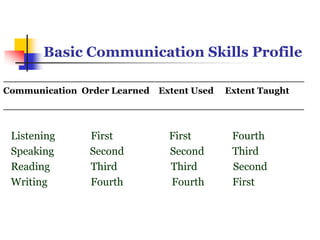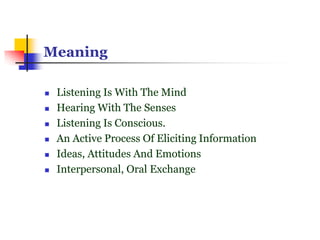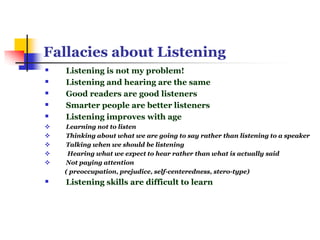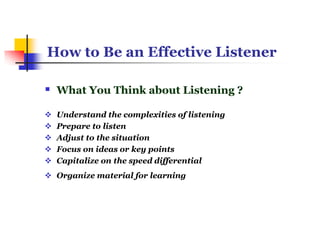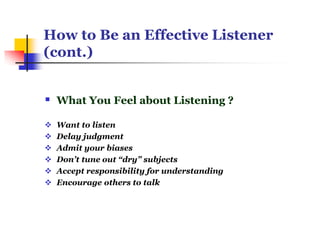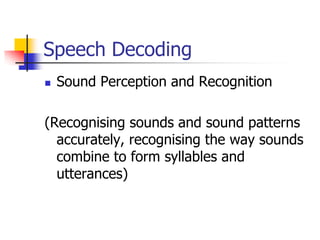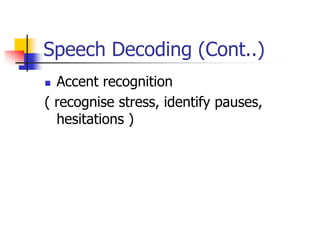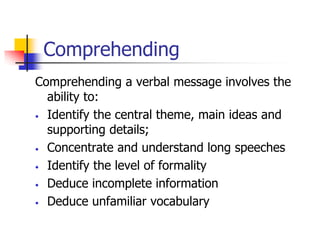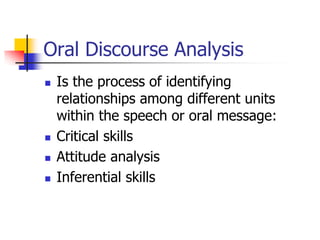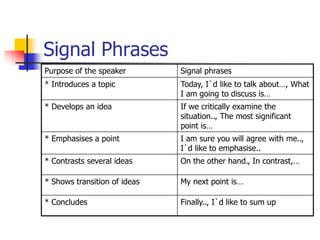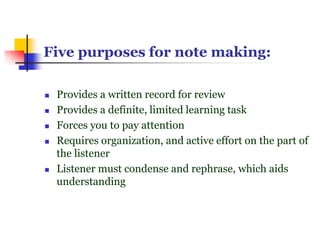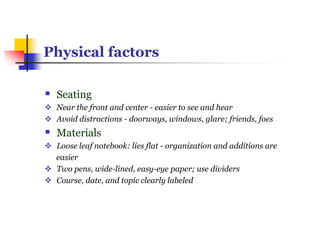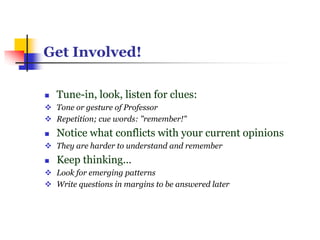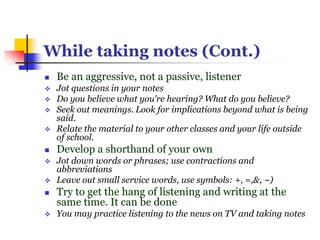Listening skills
- 2. Basic Communication Skills Profile ________________________________________________ Communication Order Learned Extent Used Extent Taught ____________________________________________ Listening First First Fourth Speaking Second Second Third Reading Third Third Second Writing Fourth Fourth First
- 3. Meaning Listening Is With The Mind Hearing With The Senses Listening Is Conscious. An Active Process Of Eliciting Information Ideas, Attitudes And Emotions Interpersonal, Oral Exchange
- 4. Fallacies about Listening Listening is not my problem! Listening and hearing are the same Good readers are good listeners Smarter people are better listeners Listening improves with age Learning not to listen Thinking about what we are going to say rather than listening to a speaker Talking when we should be listening Hearing what we expect to hear rather than what is actually said Not paying attention ( preoccupation, prejudice, self-centeredness, stero-type) Listening skills are difficult to learn
- 5. Stages of the Listening Process Hearing Focusing on the message Comprehending and interpreting Analyzing and Evaluating Responding Remembering
- 6. Types of Listening Informative Listening Vocabulary Concentration Memory Relationship Listening Attending Supporting Empathizing Appreciative Listening Presentation Perception Previous experience
- 7. Types of Listening (Cont.) Critical Listening Ethos Logos Pathos Discriminative Listening Hearing Ability Awareness of Sound Structure Integration of non-verbal cues
- 8. Barriers to Active Listening Environmental barriers Physiological barriers Psychological barriers Selective Listening Negative Listening Attitudes Personal Reactions Poor Motivation
- 9. How to Be an Effective Listener What You Think about Listening ? Understand the complexities of listening Prepare to listen Adjust to the situation Focus on ideas or key points Capitalize on the speed differential Organize material for learning
- 10. How to Be an Effective Listener (cont.) What You Feel about Listening ? Want to listen Delay judgment Admit your biases Don’t tune out “dry” subjects Accept responsibility for understanding Encourage others to talk
- 11. How to Be an Effective Listener (cont.) What You Do about Listening ? Establish eye contact with the speaker Take notes effectively Be a physically involved listener Avoid negative mannerisms Exercise your listening muscles Follow the Golden Rule
- 12. Improving Listening Comprehension Listening comprehension is the act of understanding an oral message It involves speech decoding, comprehending, and oral discourse analysis
- 13. Speech Decoding Sound Perception and Recognition (Recognising sounds and sound patterns accurately, recognising the way sounds combine to form syllables and utterances)
- 14. Speech Decoding (Cont..) Word recognition ( Recognising words accurately, understanding the definitions of the words being use, recognising the way words are used un context, identifying attention signals)
- 15. Speech Decoding (Cont..) Accent recognition ( recognise stress, identify pauses, hesitations )
- 16. Comprehending Comprehending a verbal message involves the ability to: • Identify the central theme, main ideas and supporting details; • Concentrate and understand long speeches • Identify the level of formality • Deduce incomplete information • Deduce unfamiliar vocabulary
- 17. Oral Discourse Analysis Is the process of identifying relationships among different units within the speech or oral message: Critical skills Attitude analysis Inferential skills
- 18. Listening to structured talks Pre-listening analysis-determining the purpose, knowing your speaker Predicting about the content of a verbal message Using background knowledge Intensive listening
- 19. Intensive Listening 1. Listening to the introduction? • What is the position, knowledge, background, experience of the speaker? • What is his credibility? • What is the overall purpose of the talk? • What is the central idea or theme? • What is the overall structure? • What does the speaker intend to do? • What are the main points of the talk?
- 20. Intensive listening (Cont…) 2. Listening to the Body • Contains the main message-pay attention • Concentrate on verbal signposts • Recognise main supporting details of the oral message • Concentrate on visual aids
- 21. Intensive Listening ( Cont..) 3. Listening to the conclusion • Understand the main themes of the verbal message • Recognise the speaker`s focus of the talk • Concentrate on what the speaker wants the listener`s to do, or remember
- 22. Signal Phrases Purpose of the speaker Signal phrases * Introduces a topic Today, I`d like to talk about…, What I am going to discuss is… * Develops an idea If we critically examine the situation.., The most significant point is… * Emphasises a point I am sure you will agree with me.., I`d like to emphasise.. * Contrasts several ideas On the other hand., In contrast,… * Shows transition of ideas My next point is… * Concludes Finally.., I`d like to sum up
- 23. Logical Connectors and Transitional Signals Purpose of the speaker Logical connectors Adds a point Moreover, in addition compares Similarly, likewise contrasts In contrast, However, Shows segmentation Right, OK, And, Now, That`s all Exemplifies In other words, For instance Temporal Eventually, For the time being, Before Explains Therefore, Thus
- 24. Effective Note Making Note making is essential in college: For lectures, which are a highly condensed methods of passing on information For reading, because what you don't write down, you don't remember
- 25. Effective Note Making (Cont.) Note making is a skill: Most people feel deficient It can be learned This takes understanding of what you're doing It takes practice, which involves effort
- 26. Effective Note Making (Cont.) Note making is difficult because: Spoken language is more diffuse than written Speaker's organization is not immediately apparent Immediate feedback seldom occurs Spoken language is quickly gone This makes analysis difficult
- 27. Five purposes for note making: Provides a written record for review Provides a definite, limited learning task Forces you to pay attention Requires organization, and active effort on the part of the listener Listener must condense and rephrase, which aids understanding
- 28. Sequence Listen and focus on meaning Evaluate what is being said Is it relevant to your purpose? What are the high points? Record the information Make use of it
- 29. Physical factors Seating Near the front and center - easier to see and hear Avoid distractions - doorways, windows, glare; friends, foes Materials Loose leaf notebook: lies flat - organization and additions are easier Two pens, wide-lined, easy-eye paper; use dividers Course, date, and topic clearly labeled
- 30. Before taking notes - PREVIEW Prepare yourself mentally - What do you need to get out of this? Review notes from last time and homework. Nail your attention down tight. Review the outline from your reading assignment Think through what has happened in the class to date Generate enthusiasm and interest Increased knowledge results in increased interest A clear sense of purpose on your part will make the course content more relevant Acting as if you are interested can help Don't let the personality or mannerisms of a speaker put you off Be ready to understand and remember Anticipate the next step and compare what you've guessed with what happens
- 31. Get Involved! Tune-in, look, listen for clues: Tone or gesture of Professor Repetition; cue words: "remember!" Notice what conflicts with your current opinions They are harder to understand and remember Keep thinking... Look for emerging patterns Write questions in margins to be answered later
- 32. While taking notes Don't try for a verbatim transcript Get all of the main ideas Record some details. illustrations, implications, etc. Leave plenty of wide space for later additions - underscore or star major points Note speaker's organization of material Organization aids memory Organization indicates gaps when they occur - you fill in later Be accurate Listen carefully to what is being said Pay attention to qualifying words like: sometimes, usually, rarely, etc. Notice signals that a change of direction is coming: but, however, on the other hand
- 33. While taking notes (Cont.) Be an aggressive, not a passive, listener Jot questions in your notes Do you believe what you're hearing? What do you believe? Seek out meanings. Look for implications beyond what is being said. Relate the material to your other classes and your life outside of school. Develop a shorthand of your own Jot down words or phrases; use contractions and abbreviations Leave out small service words, use symbols: +, =,&, ~) Try to get the hang of listening and writing at the same time. It can be done You may practice listening to the news on TV and taking notes
- 34. POST VIEW: Don't move - go over notes at once! Review and reword them as soon after class as possible Build review time into your schedule Don't just recopy or type without thought "Reminiscing" may provide forgotten material later Rewrite incomplete or skimpy parts in greater detail Fill in gaps as you remember points heard but not recorded Arrange with another student to compare notes Find answers to any questions remaining unanswered Write a brief summary of the class session Formulate several generalized test questions based on the material
- 35. POST VIEW: Don't move - go over notes at once! (Cont.) Use your notes as a learning tool Review at spaced intervals it is more effective than the same effort spent cramming We forget 50% of what we hear immediately, two days later, another 25% is gone. But relearning is rapid if regular review is used. Compare the information in your notes with your own experience - don't swallow everything uncritically Don't reject what seems strange or incorrect. Check it out. Be willing to hold some seeming inconsistencies in your mind over a period of time. Build a good "thought map" of the ideas. Explain it to anyone who'll listen. Memorize that which must be memorized.
- 36. THE TEN COMMANDMENTS – KEITH DAVIS Stop Talking. Put The Talker At Ease. Show Him That You Want To Listen. Remove Distractions. Empathize With Him. Be Patient. Hold Your Temper. Go Easy On Arguments And Criticism. Ask Questions. Stop Talking!
- 37. Thank You

